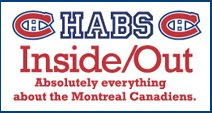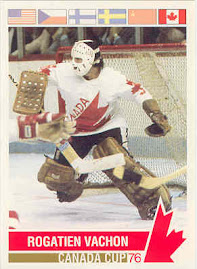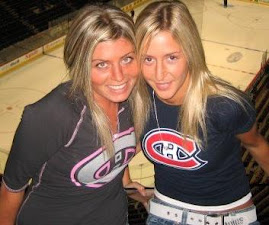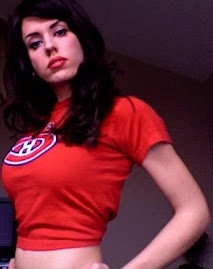
After one full season as a 10 team NHL, it was evident that the scope of professional hockey had never looked brighter. Business was good for the league, especially in the United States where several new franchises had established themselves rather quickly. With the NHL heading into it's 11th season, it's days of meagre beginnings as a four team league focused mainly in eastern Canada were long gone. There were now 6 U.S. franchises among the group, and fans in these newer cities invited into the NHL seemed to take to the sport rather rabidly.
There were still underlying issues for the league in evolving the sport, but it's main concerns were all about building strong allegiances with fans in each NHL city. There was a certain amount of parity among the teams, with up to six or seven strong clubs displaying a high calibre of hockey prowess.
HOCKEY NEEDED A HERO
Perhaps what the game needed most to continue growing, was it's own version of a Babe Ruth - some larger than life figure to bring the game and its excitement to new heights. A household name, that when folks heard it, immediately associated to the sport of hockey. A player whose exploits would rise above the norm, capture imaginations, and propulse the sport into a greater sphere of appreciation, was beckoning.
While it may be difficult to imagine a highlight reel hero emerging years before the invention of the televison, NHL hockey needed such a player in the days when newspaper headlines, radio broadcasts, and word of mouth were all that were available to help spread word of this great game of hockey.
With the disapppearance of the WHL, it was without doubt that the present NHL grouped the best professional hockey players in the world. Frank Boucher, and brothers Bill and Bun Cook filled the seats in Madison Square Garden. In Boston, defenseman Eddie Shore was something to witness, and the Bruins were an always exciting squad with the likes of Cooney Weiland, Dit Clapper, and Harry Oliver. The Montreal Maroons brought in Hooley Smith, and he anchored the infamous and very offensive "S" line with Nels Stewart and Babe Siebert. Other hockey stars were sprinkled throughout the NHL.
Professional hockey was indeed still in it's infancy in the late 1920's. It was a time when, after the first World War, innocence gripped onto collective consciences, and dreams of prosperity and wealth were firm realities within reach for all. Sport may have had it's appeal as a distraction from a normal way of life then, as now. Hockey, as all sports have always been and always will be, was just another invitation to dream of a better way of living.
THE FLYING FRENCHMAN MYSTIQUE
The Montreal Canadiens in all of this, had long gripped it's own city in a passion for the game. In truth, the passion for the game of hockey in Montreal was actually older than the Canadiens themselves. Long before the Canadiens had a history, the city of Montreal had a winning history in the game of hockey.
It is perhaps blurred in history as to why, but early on a certain level of excellence was demanded of Montreal hockeyers. In Ottawa, hockey championships were won almost as often, but the winning didn't seem to carry with it the same mystique, reverance or appreciation.

Maybe it all had to do with the perception of the "Flying Frenchman" as the game's earliest masters. In an era when myth carried slightly more weight than fact, a romantic curiosity had built up among fans of the game concerning the Montreal Canadiens team. In fact, because of this myth, and because of the romantic curiosity of hockey fans, the Canadiens team became a drawing card to the game beyond the borders of Montreal. It started to become quite apparent when fans began showing up in larger numbers in visiting arenas for games in which the local team would face these "Flying Frenchmen".
It was a perception that did not take hold in Ottawa or Toronto per se, but in the American cities in this era. Names such as Lalonde, Joliat, Morenz, and Vezina sounded more foreign than O' Brian, Smith, and McDonald did. To separate fact from myth, only goalie Vezina and Lalonde were french fluent, as Joliat and Morenz were born in Ottawa and Stratford, Ontario respectively and were of Swiss ancestry. Beyond these barely bilingual early stars of the team fastly becoming known as "Les Habitants", the makeup of the early editions of "Les Canadiens" were mostly home bred and born, french speaking Quebecers.
MARKETING THE MYTH
It all draws back to the creation of the Montreal Canadiens club in the 1909 NHA, whereupon initial team owner Abrose O' Brien thought it a smart move financially to capitalize on the language rivalry possiblitity in Montreal when establishing the Canadiens as a rival team to the english fanbase inherant in countering both the Montreal Wanderers and Montreal Shamrocks teams. Little did O' Brien know, or for that matter, successive owners George Kendall and the Leo Dandurand group, that they would take part in the perpetrating of a myth that would forge the identity of the team for up to one hundred years.
 History would show, that about this time, Dandurand would begin to catch on to the "Flying Frenchman" mystique south of the border. Smart promoter that he was, he was cautious and cunning in how to make a good buck from it.
History would show, that about this time, Dandurand would begin to catch on to the "Flying Frenchman" mystique south of the border. Smart promoter that he was, he was cautious and cunning in how to make a good buck from it.During the 1928 hockey playoffs, the Montreal daily "La Patrie" published a popular column where Morenz gave his impressions on the teams involved and the play of his team, the Montreal Canadiens. Interestingly, Morenz did not write in French and the columns were ghostwritten by Charles Mayer, sportswriter for the newspaper.
MORENZ HOCKEY'S FIRST SUPERSTAR
Dandurand would never do a thing to dispell the myth or dampen the curiosity when it came to the NHL's first superstar.
Howie Morenz, in hindsight, accomplished a great deal more than his numbers suggest. His achievements, in view of the game of hockey as a whole, are more meaningful in league terms than they are in Montreal Canadiens terms, historically speaking. Much of what Morenz would soon accomplish had more to do with style and pizzaz than simple numbers and statistics could ever explain.

Breaking records, making headlines, and gathering crowds were but a fraction of the spectacle Morenz and the Canadiens would deliver starting in 1927. It was the launching of a brand that would become known as firewagon hockey - a no holds barred offensive assault based on speed and the ability of execution. As the rules of the primitive game of hockey would open up, and evolve to accept and promote it's speed versus physicality aspect, Morenz was at the forefront of the discovery as to just how exciting a game of hockey could be.
The combination of Howie Morenz's speed, style, and skill, the "Flying Frenchman" mystique, records being shattered, and the popularity of hockey in new markets, helped create exactly what the NHL needed in 1927.
And a superstar was born.
Howie filled arenas like no one had before. His blazing speed electrified crowds wherever he played. A few years prior, when an exhibition game had been held in Boston to see if hockey could work there, Charles F. Adams applied for a franchise in Boston. When Tex Rickard watched Howie in action, he got Big Bill Dwyer to get a New York franchise and insisted that Howie and the Montreal Canadiens be the opponent in the New York Americans first home game. From there, Boston and New York were sold on hockey. Capacity crowds greeted Howie and the Canadiens when they played in NHL cities.
On the Canadiens, Morenz teamed with Aurel Joliat on the left - hardly a slauch himself - and Arthur Gagné on the right, to form the NHL's highest scoring line. They scored 33, 28, and 20 goals respectively, for a total of 81. They finished first, second, and sixth in NHL scoring, and the Canadiens set a new NHL high of 116 goals.
Morenz set a new points record with 51 and assists by a center with 18.
Along the course of Morenz's record setting season, a New York newspaper made light that the Americans team offered the Canadiens $50,000 for the services of their star, only to be rebuffed by Dandurand who claimed that their wasn't enough money on Wall St. to snag the Habs sniper.
Imagine, five seasons previous, a worried Morenz was unsure of his ability to turn pro.
In 1928, Morenz was a more than worthy Hart Trophy winner.
THE KENNEDY CUP
The family of former team owner George Kennedy, with the approval of the NHL, donate a trophy in his name to the Canadiens / Maroons rivalry. The Kennedy Cup, as it becomes known, will be awarded to the Montreal club winning the season series between the two teams. Should the teams number the same total of wins, goals scored would then decide the winner.
 The trophy would be handed out 11 times, until the Maroons final season in 1937-38, and would be highly contested through many memorable battles. The trophy also becomes a point of pride among the english and french supporters of each team.
The trophy would be handed out 11 times, until the Maroons final season in 1937-38, and would be highly contested through many memorable battles. The trophy also becomes a point of pride among the english and french supporters of each team.In total, the Canadiens would edge out the Maroons 6-5 in wins, with the sixth title coming amid much controversy. In 1937-38, it is decided that in the event of a tie involving season victories, the tie breaker would now be individual wins since the inception of the trophy rather than goals scored per season. After the Maroons won the first four games of the season, the Canadiens fight back to claim the final four. With both teams totalling the same number of goals, the ammended new tie breaker gives the Canadiens their sixth Kennedy Cup, with a narrow margin of 30 victories to the Maroons 29.
 Each annual win the Habs is celebrated with great fanfare by the team's fans through the streets of downtown Montreal. A team fan club known as "The Millionaires" would go all out with banners and air horns, while parading the streets much to the displeasure of Maroons supporters.
Each annual win the Habs is celebrated with great fanfare by the team's fans through the streets of downtown Montreal. A team fan club known as "The Millionaires" would go all out with banners and air horns, while parading the streets much to the displeasure of Maroons supporters. "La Patrie" reports that the Canadiens players even received bonuses for winning, such as the $100 offered by Canadiens owner Louis Létourneau upon occasion.
With the popularity of the team and it's individual players came companies soliciting their services and good name for advertisements. One of the first was for Pit Lepine endorsing Buckingham Cigarettes, claiming that they did not cause itchiness in his throat.
CANADIENS SET NEW MARKS
In 1927-28, the Canadiens had as good a season as the year prior with a 26-11-7 record. On the surface there seemed to be traces of parity around the NHL, but the league had reduced the overtime period from 20 minutes to 10, and with it, the number of ties in the NHL rose from 18 to 37. Hence, the Canadiens won two games less, yet finished one point ahead of their previous best with 59.
The Canadiens returned with much the same team, and the results were status quo. Coach Cecil Hart and captain Sylvio Mantha remained and Marty Burke, Charles Langlois, George Patterson, and Leo Gaudreault were the new player additions to the squad. Not returning from 1926-27 were Arthur Gauthier, Peter Palangio and Carson Cooper.
 Gaudreault was signed as a free agent on October 7, 1927 and would stick with the team for a decade, though his bigger contributions would come as a Providence Reds member. Defenceman and part time winger Charles Langlois played 32 games with the Canadiens in his only season with the team. Marty Burke was acquired on loan from the Pittsburgh Pirates on December 16, 1927 in exchange for Langlois over the balance of the season. Burke would sign on with the Canadiens and play five more seasons in a Montreal uniform.
Gaudreault was signed as a free agent on October 7, 1927 and would stick with the team for a decade, though his bigger contributions would come as a Providence Reds member. Defenceman and part time winger Charles Langlois played 32 games with the Canadiens in his only season with the team. Marty Burke was acquired on loan from the Pittsburgh Pirates on December 16, 1927 in exchange for Langlois over the balance of the season. Burke would sign on with the Canadiens and play five more seasons in a Montreal uniform.  Patterson arrived in time to play in 16 games for Montreal after being acquired from Toronto for cash on February 8, 1928.
Patterson arrived in time to play in 16 games for Montreal after being acquired from Toronto for cash on February 8, 1928. It would mark the first ever transaction between the storied rivals and Patterson would be the first player to don both the Habs and Leafs sweaters. He would be sold to Boston a year later for a cash sum.
 SENATORS BEGIN DOWNSLIDE
SENATORS BEGIN DOWNSLIDEThe Habs main competitiors in the Canadian Division were still the Senators and Maroons. While their cross town rivals were slightly improved upon the season, Ottawa were facing some issues that weakened the team. They were now by far the smallest market now in the league, were beginning to be affected by franchises in the U.S. Escalating salaries brought on by larger American crowds at games hardly made the Senators competitive. Part of the problem in Ottawa was that fans tended to only attend games with Canadian opponents such as the Canadiens, Maroons, and Maple Leafs. They were in financial trouble as a result and requested a bigger road receipt from the other teams.
To compensate for losses, they sold their star right wing Hooley Smith to the Montreal Maroons for $22,500 and the return of right winger Punch Broadbent, followed by the sale of defenceman Ed Gorman to Toronto. Despite Ottawa's financial difficulties, Alex Connell, Ottawa goalkeeper, set an all time record with six consecutive shutouts or a period of 460 minutes and 59 seconds without being scored on.
HABS ON FIRE IN FIRST HALF
With few alterations to their overall look, the Canadiens were early favorites to do very well within the Canadian Division, and they did not disappoint. Thanks in part to the limited 10 minute overtime, the Canadiens lost only once in their first 22 games.
 A 6-1 opening night win against the New York Americans was followed up by a 1-1 with the Maroons four nights later. Next was a 4-0 blanking of the Pirates - Hainsworth's first of 13 shutouts. A long five day layoff preceded their first ever game in Detroit, as the Cougars matches were previously held on Canadian soil in Windsor, Onatrio, while awaiting completion of the Olympia Arena they now called home. Losing 2-0 to Detroit might have stung the Habs, as they embarked on a team record 18 game unbeaten streak.
A 6-1 opening night win against the New York Americans was followed up by a 1-1 with the Maroons four nights later. Next was a 4-0 blanking of the Pirates - Hainsworth's first of 13 shutouts. A long five day layoff preceded their first ever game in Detroit, as the Cougars matches were previously held on Canadian soil in Windsor, Onatrio, while awaiting completion of the Olympia Arena they now called home. Losing 2-0 to Detroit might have stung the Habs, as they embarked on a team record 18 game unbeaten streak. They won the next two games decisively, beating the Blackhawks 5-2 in Chicago before returning home to shutout the New York Americans 4-0. A 1-1 tie in Boston halted the shortlived winning streak, but a 2-1 overtime win against the Maple Leafs on December 8 started the machine rolling. They'd win their next five, against Rangers, Cougars, Maroons, Bruins and Hawks, before Pittsburgh slowed them slightly with a 2-2 on Christmas Eve. They tied the next game, a scoreless draw in Ottawa before stringing off seven consecutive wins from New Year's Eve until January 17.
They won the next two games decisively, beating the Blackhawks 5-2 in Chicago before returning home to shutout the New York Americans 4-0. A 1-1 tie in Boston halted the shortlived winning streak, but a 2-1 overtime win against the Maple Leafs on December 8 started the machine rolling. They'd win their next five, against Rangers, Cougars, Maroons, Bruins and Hawks, before Pittsburgh slowed them slightly with a 2-2 on Christmas Eve. They tied the next game, a scoreless draw in Ottawa before stringing off seven consecutive wins from New Year's Eve until January 17.With a first half record of 17-1-4 after 22 games, it was doubtful that anyone would catch the Canadiens, but with a strong finish, the Maroons gave the Habs a good run.
When the Maroons shutout the Canadiens 2-0 in their 22nd contest, the Habs rivals had an 11-8-3 record at midpoint.
LOSS OF LEPINE HURTS
In the Canadiens next fourteen games, they'd win but 3 and tie 4 times, while their Forum room mates went on a 13-6-3 tear down the stretch. The Habs had lost star center Pit Lepine at the 20 game mark, and simply were not the same team without him.
The two teams met on March 3, and the 3-2 overtime loss suffered by the Canadiens seemed to smarten them up. The 13 point gap at midseason was now but a three point spread, and the Canadiens could now feel the Maroons breathing down their necks. The Habs had eight games remaining, and they would go on to win six of them, including a 3-0 shutout of the Maroons one week after the overtime loss. The Maroons went 5-2 in their final seven to finish with 54 points, five back of the Canadiens.
 The Canadiens were awarded the O'Brien Trophy, which had been reintroduced this season as the prize for winning the Canadian Division. The Prince of Wales Trophy was earned by the American Division leading Boston Bruins. Boston, thanks to the great play of Eddie Shore and goalie Hal Winkler - who tied Ottawa's Alex Connell for the lead in shutouts with 15 - finished first for the first time.
The Canadiens were awarded the O'Brien Trophy, which had been reintroduced this season as the prize for winning the Canadian Division. The Prince of Wales Trophy was earned by the American Division leading Boston Bruins. Boston, thanks to the great play of Eddie Shore and goalie Hal Winkler - who tied Ottawa's Alex Connell for the lead in shutouts with 15 - finished first for the first time.CANADIENS PLAYERS AMONG LEADERS
Goalie George Hainsworth, was proving to be more than just an able replacement for the legendary Vezina. He was becoming quite dominant, as shooters could not seem to solve him with any regualrity. After allowing on 67 goals against in 44 games in his first NHL season, Hainsworth bested that mark by allowing only 48 - good for a 1.05 goals against average. Incredibly, he would shrink both those stats a season later.

While Hart Trophy winner Morenz kept spectators in every city on the edge of their seats, he was backed up by the NHL's most potent offense with 116 goals. After the 81 goals scored by the Morenz, Joliat, and Gagné trio, eight other regulars helped contribute 35 goals.
With Lepine's return imminant, a confident Canadiens team awaited the winner of the two game Maroons and Senators showdown.
The Maroons took on the third place Ottawa club that had finished four points behind them. They had a 2-3-1 record against the Senators during the regular season, but ended up sweeping the series with wins of 1-0 and 2-1.
A battle of Montreal, and a trip to the Stanley Cup final, would be fought out on the dual home ice of the Forum.
HABS AND MAROONS BATTLE IT OUT
The first contest, played before a divided sellout crowd provided no winner, ending in a 2-2 draw, with Art Gagné and Albert Leduc scoring for the Canadiens. With everything on the line three nights later on the same ice, overtime was needed to decide the game. Unsung hero Russell Oatman of the Maroons, gave the darker sweatered team the 1-0 win in the two game total goals series.
 After getting off to such a strong start, the disappointment was bitter for the Canadiens. However, the team as a whole were just entering their prime, and there was no reason to believe they could not be a top team again the following season.
After getting off to such a strong start, the disappointment was bitter for the Canadiens. However, the team as a whole were just entering their prime, and there was no reason to believe they could not be a top team again the following season. A RANGERS - MAROONS FINAL
In the American Division, the Rangers knocked off the Pittsburgh Pirates 6-4 in a rough semi-final series, and then beat Boston 5-2 to advance against the Maroons. The annual Barnum and Bailey circus knocked the Rangers out of the Madison Square Garden arena and into the Forum for the entire seris, even though Boston offered to host the Rangers games.
The Maroons won the opening game 2–0, with Nels Stewart and goaltender Clint Benedict the stars.
Drama took over in game two when Nels Stewart fired a shot that struck New York goalie Lorne Chabot in the eye. Unable to continue, the Rangers needed a replacement for Chabot but Maroons coach Eddie Girard denied them the use of Ottawa's Alex Connell or minor leaguer Hugh McCormick. Ranger coach Lester Patrick, in anger, decided to don the pads himself. The Rangers then pasted any Maroon who got near Patrick. Bill Cook scored, putting the Rangers ahead 1-0, but Stewart was not to be denied and tied the game. In overtime, Frank Boucher netted the winner for the Rangers and they carried Patrick, tears streaming down his eyes, off the ice.

Joe "Red Light" Miller, the New York Americans goalie, was allowed to take Chabot's place in goal and he played well in a 2-0 loss in game three. Miller remained for the rest of the series, and Boucher starred again in game 4, as the Rangers won 1-0.
Miller suffered a similar fate to Chabot in game 5, but continued on despite an open gash. Controversy erupted and the crowd became hostile when official Mike Rodden disallowed a goal by the Maroon's Oatman. NHL president Frank Calder even became a target of some fan's wrath for not intervening. The Rangers, in only their second NHL season, held onto the 2-1 margin to become the second American team to win the Stanley Cup. They also became the first NHL American team to claim Lord Stanley's mug.




































































































































































No comments:
Post a Comment